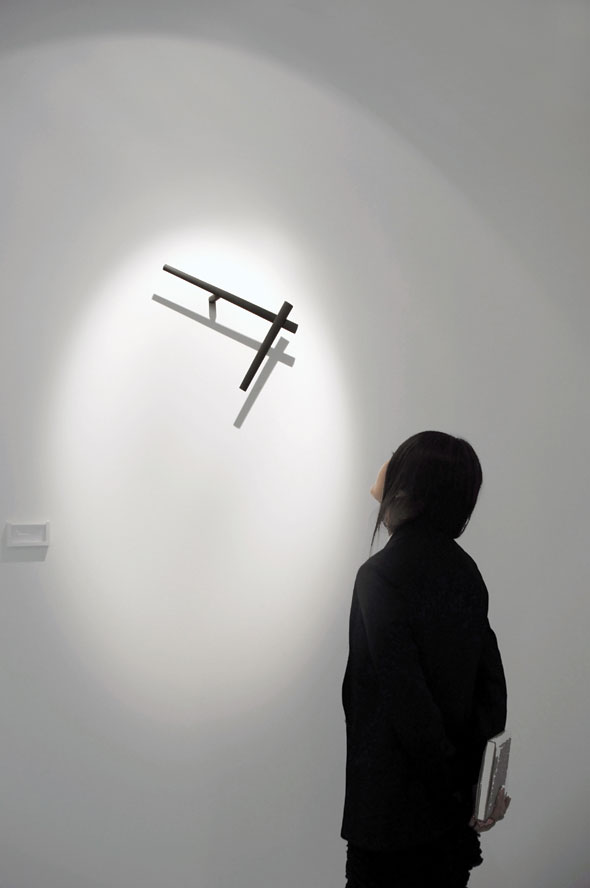
What would happen if we dislocated time or perhaps split it in two? While the concept of changing time or perhaps stretching time in its mechanical and precise terms is an interesting thought, a much more appealing concept is getting more quality time and staying more focused on what really matters. We honor anyone who dares give it a try.
Hanhsi Chen, a young, Taiwanese-born, now London-based designer, seems to offer us just that—a new take on how we perceive time. It makes us stop, take a break, and truly consider what time really is. And while his concepts of the “Dislocation Clock” and “Distance = Time” were both created a few years ago, it has become increasingly relevant to explore another approach to time and time spent. If something is truly timeless, what does it matter when we cover it?
“What is time? While people celebrate the precise mechanism of a timepiece, Einstein’s theory of relativity reveals the nature of time, and a universe without absoluteness.”
Chen was born in Taipei, Taiwan in 1984. He originally earned a degree in physics from National Taiwan University in 2006, but decided to explore the world of design, production, and objects with his scientific eye. He moved to London where he was accepted to the highly acclaimed and creative university, Royal College of Art, or RCA—known as one of the world’s most influential art and design schools. These years in London completely offered Chen a new perspective and view on the world while strengthening his acknowledgement of design. Chen graduated from RCA in 2010 with an MA in Design Products.
He’s still in London and has recently started a design studio in West London—the Logical Art Studio—with fellow RCA graduate, Yoo-Kyung Shin. Together they have set out to explore the intersection of technology and craftsmanship—merging their talents in art, design, and illustration. They create everything together from lighting and clocks to accessories and experimental design.
At first glance, Chen’s “Dislocation Clock” looks like an ordinary clock with solely two hands. But, after a while, you may find the position of the clock is slightly different, as if its center seems to be vanished. Simply shifting the rotating pivot from center to the other end of the minute hand creates this unexpected, yet recognizable movement. The result is a clock that re-positions itself on the wall as time progresses. The two hands reflect the usual passage of time. But together as a unit, they rotate in various configurations, striking a surprising balance with each move.
“Dislocation clock do not intend to create a new meaning of telling time, but to re-configure an archetype with a new life, which makes you re-think the concept of time.”
The clock becomes almost meditative to watch—the movement of something so ordinary has been transformed into long, fluid, and elegant moves. But basically, it is a clock with a slightly dislocated center—minimal and simple, yet extremely powerful.
Another of Chen’s unique timepieces that deserves some recognition is the “Distance = Time” or “Dual Time” wristband. Also part of his graduation exhibition from RCA, this watch design is for long-distance couples, friends, or whomever dear you might have far away with a unique feature—complimentary hour hands. Each individual has its own piece and together they can stay in perfect sync.
These pieces have three hands. And where this would normally mean hours, minutes, and seconds, these timepieces instead have two individual hour hands that move across the dial—showing the different time zones, representing he/she and yourself. While you are separated, it tells you how far away you are; after you meet again the hands meet as well—the design of these two arms is complimentary with a perfect match. The day/night are clearly informed by black and white circles.
With the beginning of a new year—and a 2012 behind us that had everyone constantly searching to optimize and fit more into our schedule—the world seems to be tired and screaming for a pause. If even just a small one, it offers an intriguing concept. Hanhsi Chen offers us all a different perspective on time—a unique outlook on transforming time into poetry and motion. And we owe it to ourselves, if not to apply, at least to consider it.
For more information, visit www.hanhsi.com
Text by Louise Brandstrup Zastrow
Photography by Hanhsi Chen

